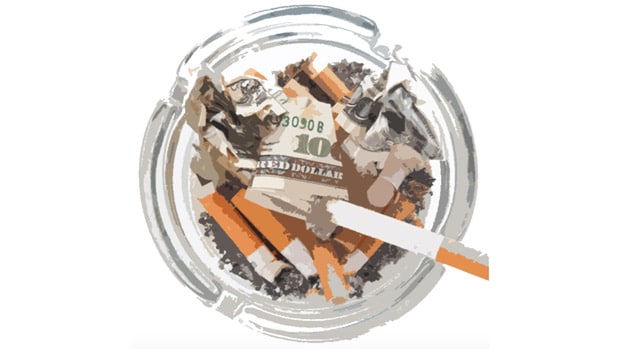
First and foremost, we are the staunchest supporters and advocates of freedom and individual liberties. It is your right to choose to smoke or not smoke.
One of the common misnomers and or psychological responses associated with anti-smoking campaigns however, is that somehow due to an organizations sharp and opposing narrative – that you should disregard it because of your right to smoke.
Again, while we’re 100% behind your personal freedoms and love the idea of challenging narratives, sometimes the correct answer is the simplest one – think Occam’s razor.
By discounting all narratives that seemingly challenge your individual liberties and using nothing more than logical thinking – as it concerns cigarette smoking, we’re sure you’ll come to the correct conclusion.
When considering to quit smoking, ask yourself the following questions. What are the problems associated with tobacco cigarettes? What exactly are the ingredients in tobacco cigarettes? How does the availability of cigarettes effect my choices to be smoke free? If tobacco cigarettes are such a menace on society – who’s being held or not held accountable? What sections and subsections of societies and populations are the most negatively affected by cigarettes?
Table of Contents
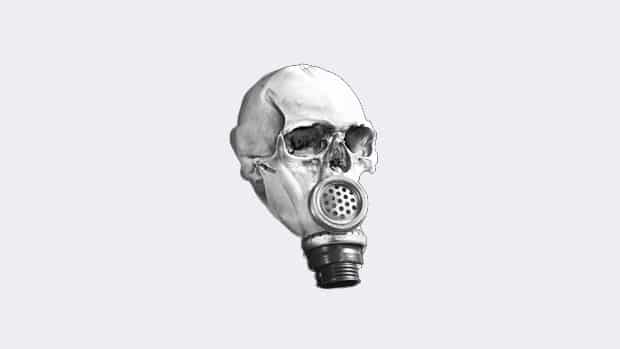
Tobacco Cigarette Ingredients
If tobacco cigarettes were so toxic, they wouldn’t be allowed in the market place. Incorrect, you’d be surprised what is possible with ‘financial influence’. Ever wonder what exactly is inside of tobacco cigarettes? How about arsenic, acetone, acetic acid, ammonia, cadmium and formaldehyde to name a few gems. (Source: American Lung Association)

Availability of Tobacco Cigarettes
One of the biggest problems concerning curbing cigarette use is the toxic products availability. You can be absolutely anywhere in the world, either incarcerated or not and have ready access to a square. 40% of US adolescents live within walking distance of a cigarette retailer. (Source: Brookings Institute)

Accountability of Tobacco Cigarette Associated Diseases
If cigarettes are a menace to society then those responsible for producing them are surely being held accountable for their own manufactured products, right? No. Accountability concerning ‘big tobacco’ is stifled by hundreds of millions of dollars in lobbying and legal battles. In the 4th quarter of 2017, ‘big tobacco’ was finally ordered by a federal court to pay for television and print ads, explaining the incredible health implications attached to their products. (Source: Public Health Law Center)

Cigarette Demographic Targeting & Misinformed Consumers
Let’s dive into the cultures and subcultures of cigarette use. How and why people begin smoking. Let’s have a look at the demographics associated with cigarette smoking. By identifying cigarette use on both micro and macro levels, we can better determine strategies to curb usage. In 2016, there were an estimated 37.8 million cigarette smokers in the U.S. 25% of which were under the poverty line. (Source: Centers for Disease Control and Prevention)
Tobacco Cigarette Ingredients
You’d absolutely never guess some of the ingredients found in tobacco cigarettes. You’d think that it wouldn’t be allowed. You’d think that it would be absurd to suggest. Understand this, ‘big tobacco’ has had their way with tobacco regulations and the results are the most addictive and toxic products readily available for retail sale in the world. There are approximately 600 ingredients inside tobacco cigarettes and when burned, they create over 7,000 chemicals. Below are just a few noteworthy or ‘stand-out’ chemicals associated with tobacco cigarettes.
Arsenic
Arsenic is the chemical element of atomic number 33, which is a brittle steel-gray metalloid. The primary use of arsenic is in alloys of lead (for example, in car batteries and ammunition). Arsenic is found in rat poison. (Source: Wikipedia)
Formaldehyde
Formaldehyde is a naturally occurring organic compound with the formula CH2O (H-CHO). Formaldehyde is a colorless, flammable, strong-smelling chemical that is used in building materials and to produce many household products. Arsenic is found in embalming fluid. (Source: National Cancer Institute)
Ammonia
Ammonia is both caustic and hazardous in its concentrated form. It is classified as an extremely hazardous substance in the United States, and is subject to strict reporting requirements by facilities which produce, store, or use it in significant quantities. Ammonia is named for the Ammonians, worshipers of the Egyptian god Amun, who used ammonium chloride in their rituals. Ammonia is a common household cleaning chemical. (Source: Wikipedia)
Source: What’s In a Cigarette?
Chemicals in Cigarettes: From Plant to Product to Puff
Video removed.
Source: Chemicals in Cigarettes: From Plant to Product to Puff
Known Chemicals Found in Tobacco Cigarettes
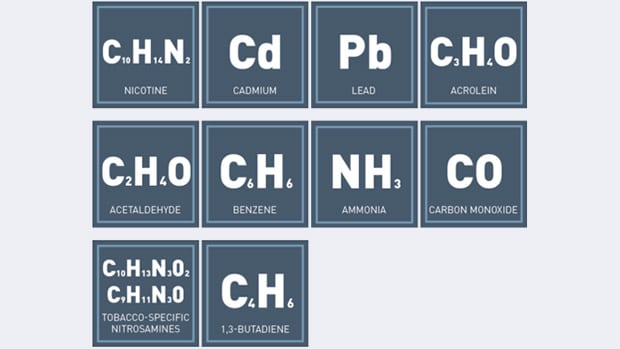
In April of 2012, the Food & Drug Administration released a list of known harmful constituents found in tobacco products as required by the Federal Food, Drug, and Cosmetic Act. This list is known as the ‘HCHP List’ (short for ‘harmful and potentially harmful constituents’ found in tobacco products.
Like any giant bureaucratic entity, the FDA is slow and susceptible to corruption (think sub-committees, committees, boards, meetings, lobbyists etc – a bastion for water-downed and weak legislation).
Remember, it wasn’t until 2009 that the FDA was actually given new authority to regulate the manufacturing, marketing, and distribution of tobacco products via the Family Smoking Prevention and Tobacco Control Act.
Look, we’re rooting for the FDA. Tobacco cigarette use is clearly on a long-term down-trend. We just of the opinion that more can be done to better inform consumers the exact and full lists of chemicals and toxins associated with tobacco cigarettes. Tobacco cigarettes are responsible for the deaths of more than 1,300 Americans every single day. The product should not even exist anywhere near it’s current form.
The FDA was able to put out a list of 93 ‘harmful and potentially harmful constituents’ found in tobacco cigarettes – approaching a decade ago.
(Source: Harmful and Potentially Harmful Constituents in Tobacco Products and Tobacco Smoke; Established List)
Anatomy of a Tobacco Cigarette
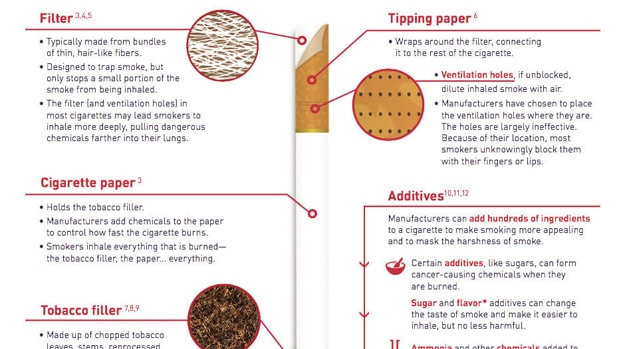
The truth is, tobacco cigarettes have been meticulously engineered to be as addictive as humanly possible. From the soil, to the tobacco leaves, herbicides, pesticides, fertilizers, papers, filters, fillers / additives, size and aesthetics, tobacco cigarettes have been named the number 1 source of preventable death in the US for good reason.
Most tobacco cigarette smokers simple don’t understand that when they smoke a cigarette, they are inhaling everything, not just ‘tobacco smoke’.
Rather, they’re inhaling hundreds of base line ingredients combined with all of the chemicals and toxins which are created in the combustion process. In other words, while hundreds of harsh chemicals is bad enough, the real silent destroyers are the thousands of toxins that are created when all of those original ingredients are burned – which is then all inhaled.
If tobacco cigarettes in their current form are going to continue to be legally sold, consumers need to know what’s inside of them and what chemicals / toxins are created when burned (at the very least). Ad campaigns should focus 100% on the core of the problem relative to smoking and that’s the actual ingredients, chemicals and toxins themselves.
Source: How a Cigarette Is Engineered
Availability of Tobacco Cigarettes
Tobacco cigarettes are a multi-billion dollar per year industry for good reason. Not only are they meticulously designed to be as addictive as possible, they are a simple (paper, chemical and ground tobacco product), relatively affordable (some of the most impoverished communities are most impacted by tobacco cigarette use) and incredibly transportable / shippable (again, available at nearly every corner store in the US).
Pricing & Taxing
The price of tobacco cigarettes has been proven to directly impact the amount of cigarettes sold, especially to the young. One of the best ways to reduce the amount of tobacco cigarette use on a nation wide scale is to increase the tax rate. A 10% increase in price has been estimated to reduce overall cigarette consumption by 3–5%.
(Source: Economic Trends in Tobacco)
Enforcing Underage Penalties
Sadly, young people have a tremendous amount of access to tobacco cigarettes. Whether illegally purchasing cigarettes themselves or getting them from friends, cigarettes are not hard to come by – anywhere. While this is a difficult problem to solve, one of the ‘no-brainer’ strategies to address underage smoking is to hold retailers accountable for underage sales.
(Source: Where Do Youth Smokers Get Their Cigarettes)
Point of Sale Marketing
There are 27 tobacco retailers for every 1 McDonald’s in the U.S. One of the most important aspects of sales in the retail market place is known as POS (point of sale). Since the 1980s, POS has been the number one venue for big tobacco marketing dollars. Advertising at the POS increases impulse purchases and normalizes tobacco in everyday life – thus discouraging cessation. Tobacco advertising or exposure at the POS encourages initiation or continuation.
(Source: Point-of-Sale Report to the Nation – The Tobacco Retail and Policy Landscape)
Tobacco Retailer and Population Density Sample Study
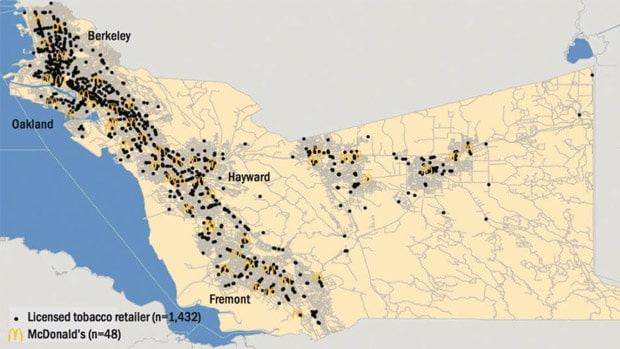
Date Set: Alameda County, CA (2012), Source: California Board of Equalization and AggData, Inc.
Cigarette Retailers Per 10,000 Consumers Sample Study
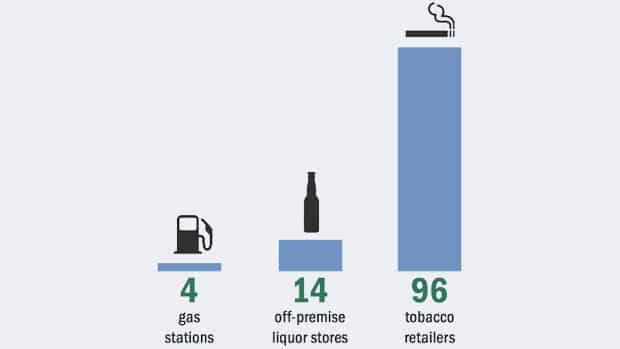
When you study the numbers relative to tobacco cigarette use, it becomes very evident that ‘big tobacco’ has been absolutely brilliant at hitting their target markets. Most of us understand that tobacco cigarettes are sold at nearly every convenience store and gas station in the country, but it’s astounding to actual see the marketing studies verifying this. Mostly of course, when considering the fact that these products are completely toxic – again the number 1 cause of preventable disease in the US, if not world.
Again, most of us know that tobacco cigarettes can be purchased almost anywhere and everywhere. According to the study however, it’s even more astonishing to recognize that people have 24 X more access to cigarettes than they do gasoline and even almost 7 X more access to cigarettes than liquor.
Therefore, when considering tobacco cigarette use an epidemic (pretty cut & dry – consumers consuming toxic chemicals), we must understand that we’re facing a perfect storm of sorts. The bottom line is that tobacco cigarette are the most addictive product on the market and they are available for purchase virtually everywhere.
Data Set: State of California, Data Sources: U.S. Census Bureau, Statistical Abstract of the United States, 2012; U.S. Census Bureau, County Business Patterns, 2011; National Alcohol Beverage Control Association, Annual Survey Book, 2012; Behavioral Risk Factor Surveillance System, 2012; California Board of Equalization, Licensed Tobacco Retailers, 2012
The Concentration of Tobacco Retailers
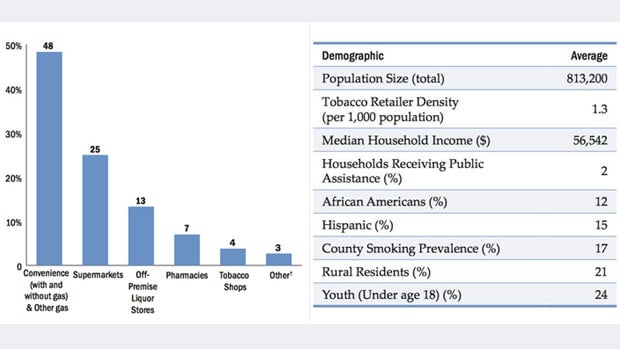
Tobacco Retailer Demographic Characteristics
We dive further into the alarming demographics associated with tobacco cigarette use later in this article, but this sample set is a good barometer. The sad fact is, lower income households and or communities have the most access to tobacco cigarettes. According to this study (and we believe other national studies corroborate) there is a large correlation specifically between households receiving public assistance and close proximity to tobacco retailers.
(Data Set: 2012 Sample Study of 97 California Counties.)
Store Type Composition of US Tobacco Retailers
Breaking down the statistics of retailers who sell tobacco cigarettes is an interesting study. Again, most people can probably guess that gas stations and convenience stores are at the top of the list. However, when digging a little deeper, you’ll find interesting current and historical alliances between the trade associations for convenience stores and the tobacco industry. Interestingly, 7-Eleven, Walgreens, Shell, Chevron, Mobil, Rite Aid and Circle K are some of the leading tobacco retailers in the Nation (by availability – not by sales data – although we certainly suspect a strong correlation).
(Data Set: 2012 Estimates for contiguous United States. † Other: Refers to a combination of discount department stores, warehouse stores, and newsstands.)
Accountability of Tobacco Cigarette Associated Diseases
The costs related directly to tobacco cigarette use in the U.S are real. Cigarettes are directly responsible for roughly 1,300 deaths in the U.S alone – every single day. Don’t get it twisted, big tobacco is without a shadow of a doubt one of the biggest plagues on our society as a whole. Unfortunately, this travesty of a situation is mostly lost on our population. People have no idea the level of systemic abuse perpetrated on their country, community, family and friends.

Number of Smokers 18+ in the U.S
According to the Centers for Disease Control’s Morbidity and Mortality Weekly Report, there were roughly 37.8 million adults in the U.S considered ‘smokers’. For percentages sake, that’s 15.5% of all adults living in the United States. What are the numbers necessary to announce an epidemic? Would large measures be taken to combat big tobacco if 25% of our entire population considered themselves smokers? If 1/4 of our entire adult population we’re smokers and in-turn 1,500 ppl died daily as a direct result of smoking, would something be done about it? What’s the number required to take action against corporatism, greed and corruption on this scale?

Economic Cost of Smoking in the U.S
Honestly, this is the section of inquiry that deserves the most attention. The total economic cost of tobacco cigarettes is roughly $300 billion – that’s $170 billion for direct medical care and $156 billion for lost productivity. The size of this pandemic cannot be understated. Take all of the personal opinions, political spin and corporate law out of the equation and just use logical thinking on top level numbers like these to have a complete understanding. Big Tobacco spends almost $10 billion a year (that’s about $1 million an hour) on advertising and promoting cigarettes. What is the result of billions of dollars being spent to sell cigarettes? The result is this: 1,300 people dying daily, almost 40 million addicted adult cigarette users, $300 billion in yearly societal economic costs and a very small percentage of people making huge amounts of profit and or ‘fees’.

Daily Deaths Attributed to Cigarettes
In the U.S, 480,000 deaths directly stem from tobacco cigarette use (41,000 of which are attributed to second-hand smoke exposure) every year. Again, that equates to about 1,300 daily deaths directly tied to smoking cigarettes. Look, we get it, a lot of smokers consider themselves rebels or counter culture. They see death as a part of life and want to ‘have a good time’ while they’re alive. Most of their lives are controlled by circumstances beyond their ability to change and tobacco cigarette use is empowering to them because they’re seemingly making the personal choice to smoke. We understand this philosophy. However, one of our prime directives is to help people understand that tobacco cigarette use isn’t ‘counter-culture’ at all and by seemingly making the personal choice to defy the world and live on your own terms (so to speak), you’re actually tapping directly into the system you think you’re defying. The absolute most counter-culture or rising above the system thing that you could possible do in modern society (believe it or not) is making the choice to be smoke-free, to be extremely pro-active in living a healthy life.
Source Data: Smoking & Tobacco Use Fast Facts
A Brief History of Tobacco Legislation & Regulation in the U.S
Smoking tobacco dates back centuries, finding it’s way into Europe and what would be the ‘civilized world’ via early European travelers interacting with American Indians in the late 1400’s.
The effects of commercialized tobacco cigarette smoking (producing, manufacturing and distributing cigarettes) however, really didn’t take hold in America until the early 1900’s.
Tobacco cigarettes as we know them today, seeped their way into American culture via an capitalist strategic timing of World War I. Yes, corporate propaganda and fake news has been around for a long, long time.
Anti-smoking organizations of the early 1900’s we’re quickly over-run by corporate tobacco cigarette campaigns who were seizing a ‘hardships of war’ narrative. (Examples: Cigarettes were said by the New York Times to “lighten the inevitable hardships of war,” and were described by a popular periodical as “the last and only solace” of the wounded”.)
Virtually, an entire generation of Americans return from the war addicted to cigarettes.
As the acceptability of cigarettes increased in American culture (essentially proving the market / product), big tobacco poured millions into favorable legislative outcomes and public relations as well as advertising and marketing campaigns.
It was an industry boom the likes of which come around only once in a century. It created huge profits for the big tobacco companies themselves and likewise, huge tax streams for governmental entities.
(Source: Tobacco Timeline – In The Beginning)
The truth is, tobacco is and always has been an enormous industry. In fact, there have been entire national economies based around tobacco. Over the past 100 years in America, tobacco has made a very small number of people (and entities) very rich and a very large number of people (consumers) very sick. Unfortunately at the core, it really is as simple as putting profits before people.
- Regulation of Production: The Tobacco Inspection Act of 1935 – Quality Standards & Auction Markets. The Tobacco Control Act of 1936 – State Tobacco Production and Attached Subsidy Rights. The Agricultural Adjustment Act of 1938 – Essentially ensuring economic stability of the tobacco industry.
- Regulation for Revenue: Federal and state taxes.
- Regulation of Consumption: Anti-smoking campaigns rise in small numbers but quickly fall. Tobacco prohibition was tied to alcohol prohibition. Big tobacco means big money for industry and government.
- State Regulation: Tobacco statutes towards minor’s consumption had staying power across the states.
- The Impetus for Federal Sumptuary Regulation: The U.S Surgeon General and other leading health organizations begin official inquires into cigarette use in the 1960’s. The truth about the dangers of smoking cigarettes begins to emerge.
- The Health Warning Requirement: The FTC concludes cigarette advertising is deceptive in 1964. The first warning label required by law on all cigarette packages – The Cigarette Labeling and Advertising Act. Consumption continued to grow.
- The Fairness Doctrine: The FCC makes headway in requiring opposing television ads to big tobacco’s misleading portrayals of cigarettes.
- The Ban on Advertising: The Public Health Cigarette Smoking Act is passed – Banning cigarette advertisements on radio and television.
All in all, there couldn’t have been a slower possible timeline for even beginning to combat the societal scale of negative effects caused by tobacco cigarettes in the United States. Frankly, the fight continues to this day.
(Source: History of Tobacco Regulation)
Significant Cases Concerning Big Tobacco

United States v. Philip Morris
In 1999, the United States Department of Justice (or DOJ) sued several big tobacco companies essentially for fraud and reimbursement of tobacco related healthcare costs. Initially dismissed by a district court judge, the DOJ was able to pursue their claim under the Racketeer Influenced and Corrupt Organizations Act (or RICO). After years of bureaucratic ineptitude, in August of 2006, U.S. District Judge Gladys Kessler issued a 1,683 page opinion holding big tobacco liable for RICO violations. She rightly called ‘big tobacco’ a massive 50 year scheme to defraud the public. Additionally, one of the biggest findings of the court (during the subsequent appeal process in May of 2009) was that the First Amendment does not protect fraudulent statements. The First Amendment ruling as it relates to deceptive and or outright fraudulent cigarette marketing practices is arguably the single most important finding in dismantling big tobacco. Furthermore, in our opinion, Judge Kessler’s 1,683 page memorandum is the single most well outlined, well written and well documented writings on the corruption, deceit, immorality and unlawfulness perpetrated by ‘big tobacco’. Literally, the only problem with it, is it’s length. Which is both a good thing and a bad thing. The good thing about it’s length is it’s all encompassing approach and detailed citations. The bad thing about such a huge piece, is that it’s fairly difficult for the average person to break-down and read in it’s entirety. We were however, able to find an excellent piece called the Tobacco Control Legal Consortium, The Verdict Is In: Findings from United States v. Philip Morris, The Hazards of Smoking (2006). This piece is shorter (although still lengthy) and breaks down some of the most important quotes and findings in the opinion.
(Sources: United States of America v. Philip Morris USA, INC. – Amended Final Opinion, Tobacco Control Legal Consortium, The Verdict Is In: Findings from United States v. Philip Morris, The Hazards of Smoking)
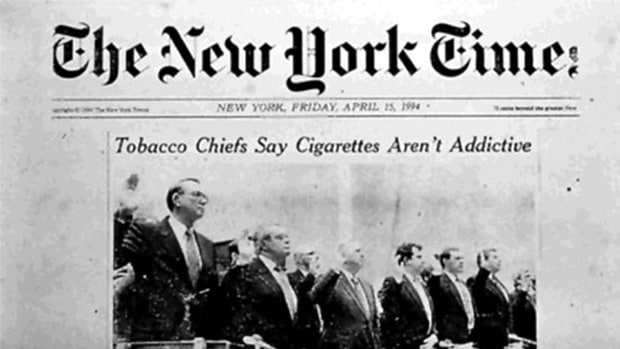
Tobacco Master Settlement Agreement
Entered in 1998, the Tobacco Master Settlement Agreement (MSA) is arguably the biggest tobacco case in the history of the U.S. The MSA essentially included 46 state attorney generals suing Philip Morris Inc., R. J. Reynolds, Brown & Williamson and Lorillard (known as the major original participating manufacturers). States were able to settle their lawsuits and recover their medicaid tobacco related healthcare costs on ‘big tobacco’s’ dime ($206 billion over 25 years). Additionally, big tobacco was ordered to end certain deceptive tobacco marketing practices and dissolve tobacco industry groups such as the Tobacco Institute, the Center for Indoor Air Research and the Council for Tobacco Research. On the face of it, the MSA was seemingly a breath of fresh air – justice seemingly being dished out. However, by dissecting the agreement, and analyzing it over time the big picture comes into view. Unfortunately, the MSA did and or does little to actually significantly curb tobacco cigarette use. In the late 90’s, the ‘cat was already out of the bag’, local, state and federal governments and courts knew that cigarettes were directly responsible for large scale deaths and overall economic costs (think smoking related healthcare costs). While courts were largely siding with big tobacco (not awarding individual lawsuits), everyone knew that tobacco cigarettes were an epidemic and big tobacco would soon have to ‘pay the piper’. The answer therefore was to finally hold big tobacco financially accountable in a big way. The end result of the MSA (along with a myriad of sideshow financial underpinnings), is states receiving huge amounts of money on a yearly bases with extremely little accountability of how the use it. In fact, not a single state funds their ‘tobacco control programs’ at the Centers for Disease Control and Prevention’s recommended levels. In 2018, states will collect a record $27.5 billion from tobacco taxes and legal settlements but will only spend $721.6 million, which is less than 3% on prevention and cessation programs.
(Source: Tobacco Master Settlement Agreement)
Cigarette Demographic Targeting & Misinformed Consumers
Modern day commercialized tobacco cigarettes seemed into our culture in a very well engineered, finely tuned and meticulously crafted way. They quietly entered through the back-door of our society and quickly spread like wild fire due to clever chemical concoctions, unaccountable marketing practices and loads of general misinformation. With all we know about the hazards of smoking cigarettes, let’s take a look at some of the current key tobacco cigarette use demographics.
Age & Cigarette Use
Age and cigarette use, particularly at young ages, has been an extremely important topic for both anti-smoking campaigns and big tobacco advocates for over 50 years. Obviously, the anti-smoking communities stance is to protect their youth from the immediate danger, addiction capability and long term health hazards associated with smoking. Big tobacco however, has know that their days have been numbered since the 1950’s and 1960’s. Knowing this, they’ve relied heavily on directly advertising and marketing to the young in an effort to ensure a stable and growing customer base.
Personal Finance & Cigarette Use
We personally don’t like to divide in any way, shape or form. We think that there’s far too many labels in society – arbitrarily attached to people. We take the stance that we are all Americans in this country, regardless of anything else. With that being said, it’s important from a epidemic standing, to understand how the perpetrators of this enormous fraud scheme have been building their empires. Frankly, the fact that roughly 25% off tobacco cigarette users are at or below the poverty line, is very telling. In this statistic, we see a multi-billion dollar industry targeting the poor among us. Let’s be clear, capitalism is about the freedom of individuals (not states) to build business and industry. Targeting and seizing on the poor with deadly products dressed in sheep’s clothing is inhumane and or evil.
Education & Cigarette Use
It’s been said that those who win the wars, write the history books. In everything that we’ve ever deeply researched, this statement couldn’t be more true. If people really understood this and applied it’s rationale to their daily lives, they’d be so much better off individually and we’d be much better off as a society as a whole. The statement directly pertains to the idea of bias. In today’s lightening fast paced world (at least in America), we bombarded with marketing and information on a second by second basis. It’s easy to remove yourself (your critical thinking – decision making) from the equation and simply become a sponge to all incoming information (without filtering it). We don’t necessarily need more college graduates (though it’s not a terrible idea), we need a smarter America. We need people who have common sense, who can think for themselves and who can identify misinformation, propaganda and or ‘fake news’.
Source Data: Smoking & Tobacco Use – Current Cigarette Smoking Among Adults in the United States
Cigarette Use Sample Study Among Education and Income Levels
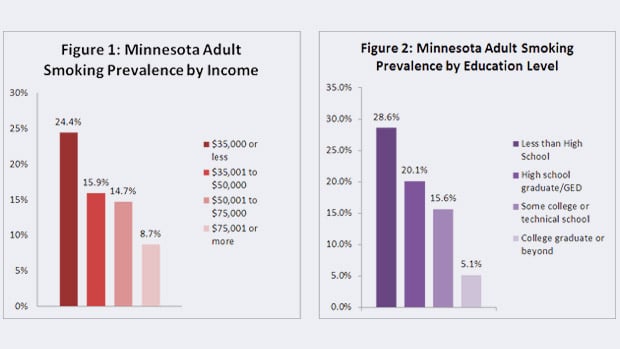
Source: Clearway Minnesota
Tobacco Cigarette Use Among High School Teens National Study
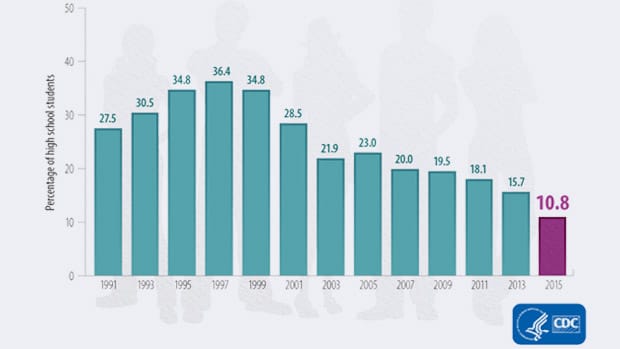
Source: National Youth Risk Behavioral Surveys

Conclusion: A Required Grassroots Initiative Against Big Tobacco
Tobacco cigarette use has been steadily declining since the 1990’s. However, an estimated 38 million Americans still smoke.
Implementing more smoke free laws, raising prices and taxes on tobacco products as well as organizing mass media campaigns will over a long period of time continue the decline.
However, for those of us who seek a much faster solution to this enormous epidemic, the answer is absolutely a grassroots initiative.
We urge people to help the cause and take a stand. It’s as simple as sharing some key statistics or now established facts regarding cigarettes to friends, neighbors and family.
You certainly don’t want to come off as offensive (putting the person on defense). You just need to politely share facts (such as those referenced in this article). Even by only planting the seed of consideration, we can make waves.
Together, we can make cigarette smoking unacceptable in society again. We can empower people to critically think about their smoking habit, the poisons they’re ingesting and the harmfulness of second-hand smoke.
With the smoking cessation technology and products available today, it’s never been easier to quit smoking.

